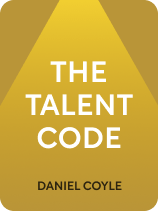

This article is an excerpt from the Shortform book guide to "The Talent Code" by Daniel Coyle. Shortform has the world's best summaries and analyses of books you should be reading.
Like this article? Sign up for a free trial here.
Do you want to expand your skillset? How do you practice effectively?
The old saying goes that practice makes perfect, which isn’t wrong. In The Talent Code, Daniel Coyle says that there are four methods for practicing meaningfully: chunking, staying attuned to flaws, condensing, and committing to repetition.
Learn how to practice with these four methods.
Method 1: Chunking
“Chunking” is a method of memorization that takes advantage of your brain’s limited memory capacity by breaking down large sequences of information into manageable pieces, mastering each of those small pieces, and building them back into the original sequence. To learn how to practice with chunking, follow these three steps:
1) Make a mental model of what you are trying to achieve: Review, in full, the skill or action you’re trying to learn. For example, if you’re working on a new piece of music, listen to a master play the entire piece. If you’re trying to nail the perfect tennis backhand, watch a professional making the movement from start to finish.
(Shortform note: Why does making a mental model of the ideal end product contribute to meaningful practice? Turns out, when you visualize yourself performing an action, you activate the parts of your brain involved in the action and fire electrical signals between the thought and action parts of your brain. This helps you “warm up” your brain to do the action correctly and contributes to the myelination of the circuits related to the action.)
2) Break the desired skill down into its individual components: Identify the individual key elements of the skill, then practice each one separately. After you’ve mastered each element, gradually connect the elements together—mastering increasingly longer sequences until you’ve built back the entirety of the desired skill.
For example, learning a new piece of music might look like identifying key parts of the song: the intro, verse, chorus, and bridge. You might first focus on the intro, breaking it down even further into its individual measures. Then, build it back up—master each measure, start playing two measures together, then three—until you can play the entire intro. Do the same with each part of the song until you can play it in its entirety.
(Shortform note: In The Art of Learning, Josh Waitzkin notes that in addition to helping you deliberately build up to mastery, incremental skill-building also enables your unique style to emerge. When you intuitively understand the elements of a skill and their interrelationship, you can combine them in creative ways. According to Waitzkin, you must honor your personal style if you want to become truly great. That means developing your skill according to what most inspires you so that you come to embody that skill as only you can.)
3) Decrease the speed: Coyle argues that repeating your desired skill at a slow speed will increase your precision because it allows you to pay closer attention to mistakes and truly understand the nuances of how all the elements fit together.
(Shortform note: Slow practice is a standard approach to learning in the field of music. But this method has become somewhat controversial among experts in music performance and education. They note that slow practice may actually be teaching you “slow habits” that are difficult to ramp up to full speed. They argue that it’s easier to practice at a faster pace and improve your accuracy later.)
Method 2: Stay Highly Attuned to Flaws
Coyle emphasizes that while practicing, you must remain intensely focused and attuned to the differences between your actual skill and your ideal skill. This allows you to quickly identify when you’ve made a mistake.
When you notice a mistake, Coyle explains that you shouldn’t just make a mental note of it and continue practicing. Instead, stop and compare your mistake to the ideal performance of the skill to identify what precisely needs improvement. Then, repeat the section again and again until you get through it without making any mistakes. This repetition of a difficult section will build up the myelin-associated with the skill until you achieve automaticity.
Effectively Using Your Mistakes for Learning
Coyle explains that noticing your mistakes is the first step to learning from them. But what’s the most effective way to ensure that you’re turning your mistakes into improvement?
In Black Box Thinking, Matthew Syed gives a four-step process for learning from errors:
- Take action using your current knowledge. Start practicing that habit you’ve been thinking about (for example, beginning a daily 30-minute morning cardio session).
- Observe how things go and gather data. You might keep a simple log in which to reflect daily on how you feel after your workout.
- Note any mistakes and analyze what went wrong. Maybe you missed a day, and you notice it was because you were tired from staying up too late.
- Use your data to make a simple, actionable change. Incorporate the feedback into your next action. In the above situation, you might adjust by turning your phone off at 9 p.m. to avoid late-night use.
Method 3: Condense Your Practice
Coyle recommends condensing your practice: Imposing constraints on the practice of your desired skill to make it more difficult. These self-imposed constraints increase talent efficiently because they create numerous new challenges: As you repeatedly work on developing your skills to overcome these challenges, you quickly build myelin. When you apply the highly-myelinated skills you built to the “real world,” you’ll perform even better, since the real-world application is less challenging than the condensed practice you’ve been doing.
(Shortform note: Research supports Coyle’s suggestion to condense. They show that, contrary to popular belief, constraints aren’t always stifling—they can actually increase productivity and innovation by fostering focus and motivation, and by helping you think outside of the box.)
For example, Coyle highlights the practice of Brazilian futsal—a popular but challenging version of soccer that uses fewer players, a smaller court, and a heavier ball. Futsal creates a condensed environment that increases the number of times a player touches the ball, makes decisions, and corrects mistakes. Coyle explains that this is the secret to why Brazil produces the world’s best soccer players—playing a regular soccer game is easy compared to playing futsal.
(Shortform note: Many futsal organizations mention Coyle and The Talent Code on their websites as evidence for why futsal is the perfect practice for developing soccer skills. In the book, Coyle provides a case study of an English coach bringing futsal to the UK with astounding results. Since the publication of The Talent Code, futsal has spread internationally—the USA’s first professional league was founded in 2016, and futsal made its first appearance in the Olympics in 2018.)
Method 4: Commit to Repetition
Coyle emphasizes that repetition, not just challenge, is necessary to your myelin—and talent—development. Remember: The amount of myelin in the brain is directly proportional to the hours of practice you put into a skill. The more you fire a circuit, the more myelin your brain will build around it. He says that psychologists who study expert performance have noted that a master in any field is the result of 10 years, or 10,000 hours, of committed practice.
(Shortform note: Be aware that there is a limit to how much meaningful practice you can do in a day. Anders Ericsson, author of Peak, explains that most novices can only accomplish about an hour a day of focused, meaningful practice. Experts who have extensive experience can train themselves to practice meaningfully for up to four hours, but rarely are able to exceed this.)
Making Myelination More Effective
Other authors focusing on the concept of meaningful practice offer numerous strategies that you can use alongside Coyle’s suggestions to make your practice more effective.
Limit distractions: In Deep Work, Cal Newport finds that distraction changes your brain on a molecular level by interrupting myelination. Newport explains that in environments of deep focus without distractions, myelination seems to be more effective.
Practice retrieval: The authors of Make It Stick note that most people think that reciting or re-reading new information is the best way to commit it to memory, but that’s not the case. Instead, they explain, the most effective way to improve retention of new information is through retrieval practice—any exercise that requires you to recall what you’ve learned (like a quiz). The harder your brain has to work to retrieve information, the more firmly it’s cemented in your memory.
Interleaving: In A Mind for Numbers, Barbara Oakley discusses the concept of “interleaving”—when multiple kinds of problems are mixed together in review, such as in a cumulative math test in which consecutive problems are drawn from different chapters of the book. Interleaving requires learners to analyze each problem before determining how to solve it, which engages their abstract, strategic mindset. This is more difficult than it would be if all the problems of one type were “blocked” together, but it vastly improves retention.
Space your study: You will retain more knowledge if you study in short, frequent practice sessions evenly spread out over time—forcing you to recall information. Use longer intervals as you get better at retaining the information in order to keep recall difficult, and eventually you’ll remember it indefinitely.

———End of Preview———
Like what you just read? Read the rest of the world's best book summary and analysis of Daniel Coyle's "The Talent Code" at Shortform.
Here's what you'll find in our full The Talent Code summary:
- A deep dive into where great talent comes from
- The key elements of the type of practice you need to develop talent
- Why it's never too late for greatness, if you know how to grow it






